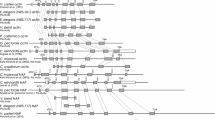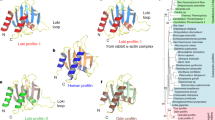Abstract
The single-copy actin gene of Giardia lamblia lacks introns; it has an average of 58% amino acid identity with the actin of other species; and 49 of its amino acids can be aligned with the amino acids of a consensus sequence of heat shock protein 70. Analysis of the potential RNA secondary structure in the transcribed region of the G. lamblia actin gene and of the single-copy actin gene of nine other species did not reveal any conserved structures. The G. lamblia actin sequence was used to root the phylogenetic trees based on 65 actin protein sequences from 43 species. This tree is congruent with small-subunit rRNA trees in that it shows that oomycetes are not related to higher fungi; that kinetoplatid protozoans, green plants, fungi and animals are monophyletic groups; and that the animal and fungal lineages share a more recent common ancestor than either does with the plant lineage. In contrast to smalls-ubunit rRNA trees, this tree shows that slime molds diverged after the plant lineage. The slower rate of evolution of actin genes of slime molds relative to those of plants, fungi, and animals species might be responsible for this incongruent branching.
Similar content being viewed by others
References
Baldauf SL, Palmer JD (1993) Animals and fungi are each other's closest relatives: congruent evidence from multiple proteins. Proc Natl Acad Sci USA 90:11558–11562
Berbee ML, Taylor JW (1993) Dating the evolutionary radiations of the true fungi. Can J Bot 71:1114–1127
Bhattacharya D, Stickel SK, Sogin ML (1991) Molecular phylogenetic analysis of actin genic regions from Achlya bisexualis (Oomycota) and Costaria costata (Chromophyta). J Mol Evol 33:525–536
Bhattacharya D, Helmchen T, Bibeau C, Melkonian M (1995) Comparisons of nuclear encoded small-subunit ribosomal RNAs reveals the evolutionary position of the Glaucocystophyta. Mol Biol Evol 12:415–420
Bhattacharya D, Ehlting J (1995) Actin coding regions: gene family evolution and use as a phylogenetic marker. Arch Protistenkd 145:155–164
Bork P, Sander C, Valencia A (1992) An ATPase domain common to prokaryotic cell cycle proteins, sugar kinases, actin, and hsp70 heat shock proteins. Proc Natl Acad Sci USA 89:7290–7294
Bruns TD, Vilgalys R, Barns SM, Gonzales D, Hibbett DS, Lane DJ, Simon L, Stickel S, Szaro TM, Weisburg WG, Sogin ML (1992) Evolutionary relationships within the fungi: analyses of nuclear small subunit rRNA sequences. Mol Phylogenet Evol 1:231–241
Cavaler-Smith T (1993) Kingdom protozoa and its 18 phyla. Microbiol Rev 57:953–994
Chan L, Zuker M, Jacobson AB (1991) A computer method for finding common base paired helices in aligned sequences: application to the analysis of random sequences. Nucleic Acids Res 19:353–358
Cole RA, Slade MB, Williams KL (1995) Dictyostelium discoideum mitochondrial DNA encodes a NADH:ubiquinone oxidoreductase subunit which is nuclear encoded in other eukaryotes. J Mol Evol 40:616–621
Doolittle RF (1992) Reconstructing history with amino acid sequences. Protein Sci 1:191–200
Felsenstein J (1989) PHYLIP—phylogeny inference package. Cladistics 5:164–166
Field KG, Olsen GJ, Lane DJ, Giovannoni SJ, Ghiselin MT, Raff EC, Pace NR, Raff RA (1988) Molecular phylogeny of the animal kingdom. Science 239:748–753
Flaherty KM, McKay DB, Kabsch W, Holmes KC (1991) Similarity of the three-dimensional structures of actin and the ATPase fragment of a 70-kDa heat shock cognate protein. Proc Natl Acad Sci USA 88:5041–5045
Förster H, Coffey MD, Elwood H, Sogin ML (1990) Sequence analysis of the small subunit ribosomal RNAs of three zoosporic fungi and implications for fungal evolution. Mycologia 82:306–312
Gunderson JH, Elwood H, Ingold A, Kindle K, Sogin ML (1987) Phylogenetic relationships between chlorophytes, chrysophytes, and oomycetes. Proc Natl Acad Sci USA 84:5823–5827
Hamelin M, Adam L, Lemieux G, Pallotta D (1988) Expression of the three unlinked isocoding actin genes of Physarum polycephalum. DNA 7:317–328
Hasegawa M, Hashimoto T (1993) Ribosomal RNA trees misleading? Nature 361:23
Hasegawa M, Hashimoto T, Adachi J, Iwabe N, Miyata T (1993) Early branchings in the evolution of eukaryotes: ancient divergence of entamoeba that lacks mitochondria revealed by protein sequence data. J Mol Evol 36:380–388
Hashimoto T, Nakamura Y, Nakamura F, Shirakura T, Adachi J, Goto N, Okamodo K, Hasegawa M (1994) Protein phylogeny gives a robust estimation for early divergences of eukaryotes: phylogenetic place of a mitochondria-lacking protozoan, Giardia lamblia. Mol Biol Evol 11:65–71
Hendricks L, De Baere R, Van de Peer Y, Neffs J, Goris A, De Wachter R (1991) The evolutionary position of the rhodophyte Porphyra umbilicalis and the basiodiomycete Leucosporidium scottii among other eukaryotes as deduced from complete sequences of small ribosomal subunit RNA. J Mol Evol 32:167–177
Huynen MA, Konings DMA, Hogeweg P (1992) Equal G and C content in histone genes indicate selection pressures on mRNA secondary structure. J Mol Evol 34:280–291
Jaeger JA, Turner DH, Zuker M (1989) Improved predictions of secondary structures for RNA. Proc Natl Acad Sci USA 86:7706–7710
Jaeger JA, Turner DH, Zuker M (1990) Predicting optimal and suboptimal secondary structure for RNA. Methods Enzymol 183:281–306
Kabnick KS, Peattie DA (1991) Giardia: a missing link between prokaryotes and eukaryotes. Am Sci 79:34–43
Kabsch W, Mannherz HG, Suck D, Pai EF, Holmes KC (1990) Atomic structure of the actin:DNase I complex. Nature 347:37–44
Le Blancq SM (1994) Chromosome rearrangements in Giardia lamblia. Parasitology Today 10:177–179.
Li W-H, Tanimura M (1987) The molecular clock runs more slowly in man than in apes and monkeys. Nature 326:93–96
Loomis WE, Smith DW (1990) Molecular phylogeny of Dictyostelium discoideum by protein sequence comparison. Proc Natl Acad Sci USA 78:9093–9097
Martin W, Somerville CC, Loiseaux-de Goër S (1992) Molecular phylogenies of plastid origins and algal evolution. J Mol Evol 35:385–404
Nikoh N, Hayase N, Iwabe N, Kuma K-i, Miyata T (1994) Phylogenetic relationship of the kingdoms animalia, plantae, and fungi inferred from 23 different protein species. Mol Biol Evol 11:762–768
Sanger F, Nicklen S, Coulson AR (1977) DNA sequencing with chain-terminating inhibitors. Proc Natl Acad Sci USA 74:5463–5467
Sarich VM, Wilson AC (1973) Generation time and genomic evolution in primates. Science 179:1144–1147
Schlegel M (1994) Molecular phylogeny of eukaryotes. Trends Ecol Evol 9:330–335
Sheterline P, Sparrow JC (1994) Actin. Protein Profile 1:1–121
Sidow A, Wilson AC (1990) Compositional statistics: an improvement of evolutionary parsimony and its application to deep branches in the tree of life. J Mol Evol 31:51–68
Sogin ML (1989) Evolution of eukaryotic microorganisms and their small subunit ribosomal RNAs. Am Zool 29:487–499
Sogin ML, Gunderson JH, Elwood HJ, Alonso RA, Peattie DA (1989) Phylogenetic meaning of the kingdom concept: an unusual ribosomal RNA from Giardia lamblia. Science 243:75–77
Sogin ML (1991) Early evolution and the origin of eukaryotes. Curr Opin Genet Dev 1:457–463
Sogin ML, Hinkle G, Leipe DD (1993) Universal tree of life. Nature 362:795
Taylor JW, Bowman BH, Berbee ML, White TJ (1993) Fungal model organisms: phylogenetics of Saccharomyces, Aspergillus, and Neurospora. Syst Biol 42:440–457
Vossbrinck CR, Maddox JV, Friedman S, Debrunner-Vossbrinck BA, Woese CR (1987) Ribosomal RNA sequence suggests microsporidia are extremely ancient eukaryotes. Nature 326:411–414
Wainright PO, Hinkle G, Sogin ML, Stickel SK (1993) Monophyletic origins of the metazoa: an evolutionary link with fungi. Science0 260:340–342
Winker S, Overbeek R, Woese CR, Olsen GL Pfluger N (1990) Structure detection through automated covariance search. Comput Appl Biosci 6:365–371
Woese CR, Gutell RR, Gupta R, Noller HF (1983) Detailed analysis of the higher order structure of 16S-like ribosomal ribonucleic acids. Microbiol Rev 47:621–669
Wolters J (1991) The troublesome parasites—molecular and morphological evidence that Apicomplexa belong to the dinoflagellatecilliate clade. Biosystems 25:75–83
Zuker M (1989) On finding all suboptimal foldings of an RNA molecule. Science 244:48–52
Zuker M (1994) Prediction of RNA secondary structure by energy minimization. Methods Mol Biol 25:267–294
Zuker M, Jaeger JA, Turner DH (1991) A comparison of optimal and suboptimal RNA secondary structures predicted by free energy minimization with structures determined by phylogenetic comparison. Nucleic Acids Res 19:2707–2714
Author information
Authors and Affiliations
Additional information
Correspondence to: G. Drouin
Rights and permissions
About this article
Cite this article
Drouin, G., de Sá, M. & Zuker, M. The Giardia lamblia actin gene and the phylogeny of eukaryotes. J Mol Evol 41, 841–849 (1995). https://doi.org/10.1007/BF00173163
Received:
Accepted:
Issue Date:
DOI: https://doi.org/10.1007/BF00173163




